February – June 2009
- June 2009 Newsletter – June 8
- April 2009 Newsletter – Apr 3
- February 2009 Newsletter – Jan 30
June 2009 Newsletter
Shows and Sales
Pala International News
Mineral and Mineralogy News
Shows and Sales
Sainte-Marie-aux-Mines – June 25–28, 2009
Pala International’s Bill Larson attends this event every year, held in the midst of the Alsace wine region of northeastern France. See Bill’s report from the 2008 show to get a taste.
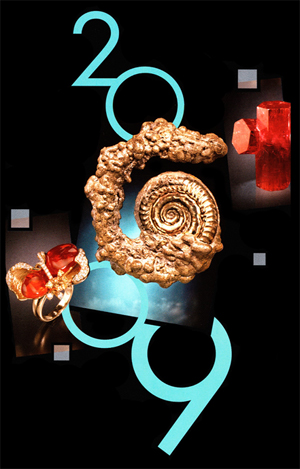 |
Bill will be joining son Will, who has been working with dealer Marcus Budil for the past two months in Munich. They, in turn, will be joined by son Carl (who worked the Vegas show last week), and friend and gem dealer Mark Kaufman. So the gang rides again—if they can just commandeer Gilles Emringer’s Ferrari...
Fluorite specimens from Asia and Africa caught the eye last year, but it is the local variety that will take center stage this year, in l’Espace Prestige, housed in Sainte-Marie-aux-Mines’ local theatre.
What: Euro-Mineral/Euro-Gem
When: June 25–28, 2009
Where: Sainte-Marie-aux-Mines, France
Bill looks forward to seeing you there.
 |
| Apéritif. This dark blue azurite from Chessy allows an area of malachite to peek through. Something to whet the appetite before Sainte-Marie-aux-Mines. Note: This specimen has been sold. (Photo: John McLean) |
[back to top]
San Francisco Fine Mineral Show
First annual exhibition features a jaw-dropper
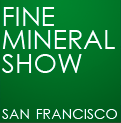 |
We recently received an email from Paul Geffner, of Washington state’s Cascade Scepters, regarding a colossal smoky amethyst quartz specimen of note. As Geffner’s colleague Joe George put it, “I'm gonna have to have my own head re-attached! The pictures do no justice for its size and grandeur.”
Well, Bay Area folk will have to keep their heads screwed on tight next month when the scepter—dubbed “Mongo,” after the hulking dull-bulb of Mel Brooks’s satirical Western, Blazing Saddles—makes an appearance at the first annual San Francisco Fine Mineral Show.
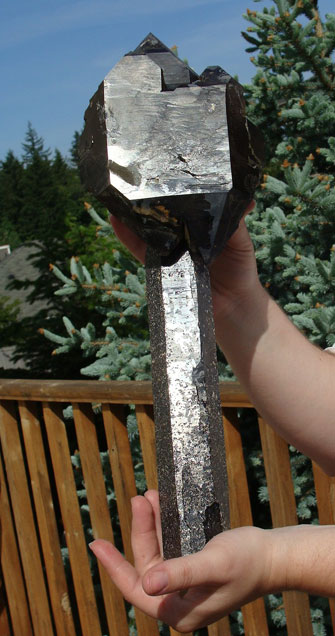 |
| Scepter or mace? Amethyst literally means “not drunk,” but it’ll take a bit of convincing yourself in the presence of this regal, two-foot-long specimen of smoky amethyst quartz. (Photos courtesy Cascade Scepters, Maple Valley, WA) |
The, er, “specimen” (does sound a little wimpy in this context) was unearthed two weeks ago by Joe George and Eric Spencer at Foster Hallman’s claim on the Nevada side of Petersen Mountain, which straddles the California–Nevada border, twenty miles northwest of Reno. Collectors refer to the locality as Hallelujah Junction (itself in California), which is a nearby convenience store. We’d bet that someone must have been cheering two weeks ago.
The piece is almost two feet long and, according to Geffner, is perfectly proportioned. As can be seen by the photograph below, the crystal faces are topped by terminations that give the piece a sense of the architectural; say, a villa above sheer cliffs.
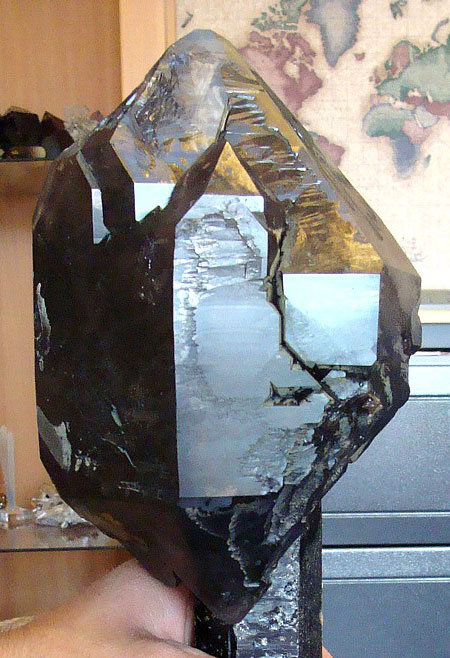 |
While Pala International is in the process of acquiring this specimen, it will be displayed along with many other fine pieces from Cascade Scepters at the San Francisco show, July 10–12. Pala’s Bill Larson will be attending and hopes to see you there.
What: San Francisco Fine Mineral Show
When: July 10–12, 2009
Where: Embassy Suites, San Rafael, CA
[back to top]
Pala International News
Pala’s Featured Mineral Specimens: Tanzanian Crystals
Merelani Hills offer a varied array of choices
The Merelani deposit in Tanzania has consistently produced a wide variety of gem crystals since its initial discovery in 1966. Along with the huge success of tanzanite in the gemstone industry, Merelani has opened up a spectacular array of intense gem crystals: lime green diopside, evergreen tremolite, mint green grossular garnet, and yellow to green zoisite crystals.
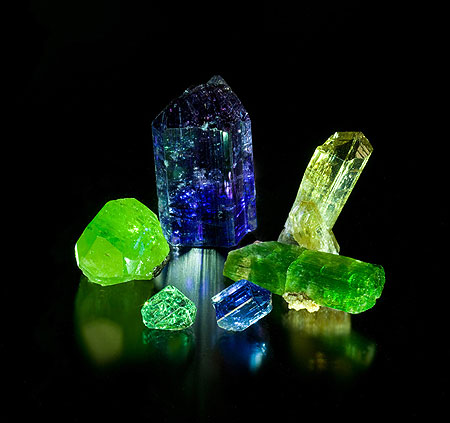 |
| Merelani mix. Clockwise from top center: tanzanite 5.5 x 2.7 cm., yellow zoisite 4.6 x 1.5 cm., tremolite 5.1 x 1.8 cm., tanzanite 1.7 x 1.1 cm., grossular garnet 0.9 x 1.4 cm, diopside 3 x 2.5 cm. From the collection of Bill Larson. (Photo: Jason Stephenson) |
As the love of tanzanite crystals has grown amongst individuals in the mineral community, their hands of desire have stretched by way of the mineral dealers, and have fostered in some miners an appreciation for pristine crystals that must be extracted with care. As higher prices have been paid for tanzanite, this crystal preservation mentality has spawned a steady stream of tanzanite crystals reaching the marketplace for all levels of collectors to enjoy. Fortunately for the connoisseur, out of this production we do see the occasional rare formation or matrix piece.
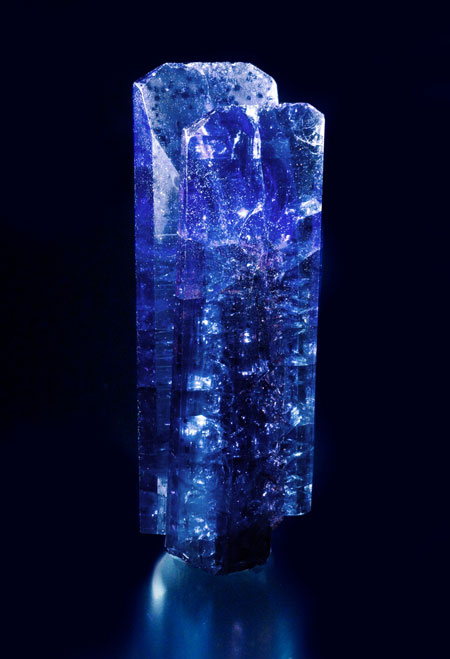 |
| Tanzanite crystal, 7.2 x 2.5 x 1.5 cm. The weight is 330 carats! Price available upon request. (Photo: Mia Dixon) |
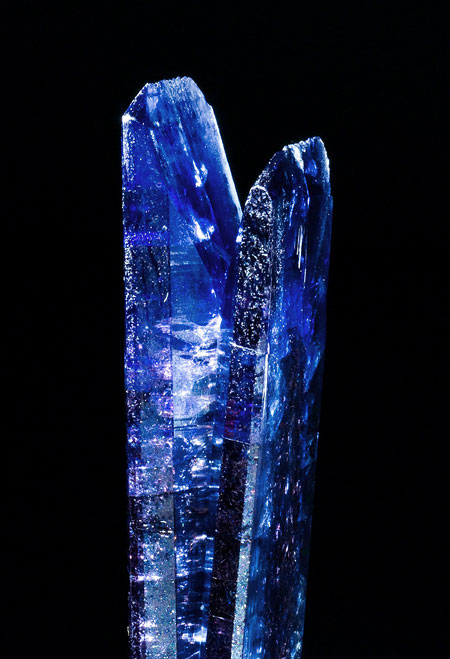 |
This month we show off a striking tanzanite crystal that seems to be in a contact twinned pattern. The inclusions create a starburst pattern with transmitted light, with a purple banded core and a blue perimeter. This delicate piece didn’t make it out unscathed, however; there is some minor damage and an excellent, clean repair.
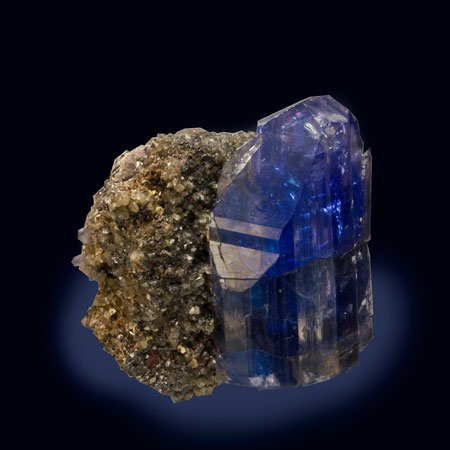 |
| Tanzanite crystal with matrix, 2.8 x 2.7 x 1.8 cm. Price: $2,000. Inventory #17398. (Photo: John McLean) |
The second tanzanite crystal surfaced with some matrix still attached, which is extremely rare because of the weak contact between the brittle graphite conglomerate and the glassy tanzanite surface. An exceptional miniature for those who collect matrix specimens.
Pala International Celebrates Forty Years
Looking Back, Looking Ahead
June 26, 2009 marks Pala International’s fortieth year as an enterprise—encompassing mining, wholesaling of colored gemstones, jewelry and lapidary design and sales, and, of course, fine mineral specimen offerings. Here are some of the highlights…
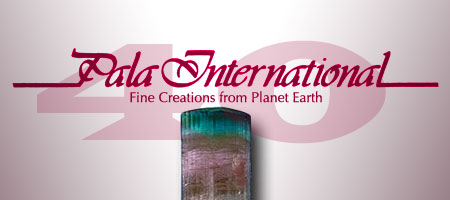 |
The Early Years: Pala Properties International
Under the co-direction of Bill Larson—himself a protégé of famed San Diego county mineral collector and curator Josie Scripps—Pala began life as Pala Properties International (PPI) in 1969. The venture was a partnership between Larson and fellow Californian Ed Swoboda, a collector who had been mining in Mexico, Africa, Asia, Australia, and South America. Swoboda brought the Stewart Lithia Mine to the table; Larson’s father, Carl W. Larson, knew Monte Moore, who owned three other patented mines in the famous Pala district: the Pala Chief, the Oceanview, and the Tourmaline Queen. Pala leased those, purchasing them in the mid-1970s.
Mine activity in the Pala district dates back to the 19th century, when gem house buyers from America, Europe, and Asia were quite interested in what the region produced. Key to demand in China was the Empress Dowager’s turn-of-the-century passion for pink tourmaline, as Larson told a Chinese audience in 2006 (see presentation here). The district has had a series of revitalizations over the years.
 |
| Classic rubellite, pink tourmaline from Pala district, Stewart Lithia Mine, San Diego County. (Photo: Jeff Scovil) |
Pala’s first successful mining was with the Stewart Mine. “We hit the lost tourmaline adit in 1969,“ Larson recalls. “It was a rich area of the mine that had been missing for sixty-plus years. We found it and started producing the hot pink tourmalines [pictured above] in various pockets. Pala put in over 12,000 feet of tunnel before we sold in 1980.” About one ton of tourmaline was produced during Pala’s operation. (John McLean, who directed those mining efforts, reckons Pala put in a total of 36,000 feet of new underground tunnel searching for gems and minerals during its forty-year history.)
Tourmaline Queen and the Find of the Century
In 1972, building upon the success of the Stewart, Pala turned to the Tourmaline Queen, which produced what it has become famous for: an unequaled group of about fifteen world-class tourmaline specimens that feature distinctive glassy “blue cap” terminations, the quintessential example from this amazing find being the “Candelabra” (photographed by Dane A. Penland). The late Vince Manson, then curator of the American Museum of Natural History, called the large pocket of tourmaline “the find of the century” in terms of color and perfection.
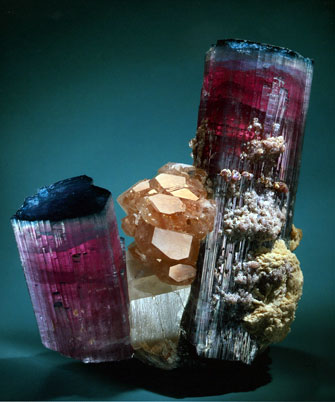 |
| Above: Blue-cap tourmaline that was the inspiration for the Pala International logo. (Photo: Harold & Erica Van Pelt) Below: Dr. Vince Manson (right), curator of the American Museum of Natural History, examines Tourmaline Queen specimens with Bill Larson. (Photo courtesy Lapidary Journal, 1972) |
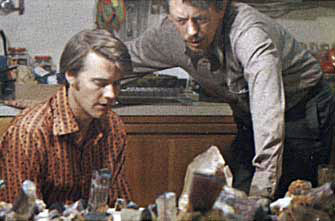 |
Pala Goes International
In the early 1970s, Pala assisted tsavorite mining entrepreneur Peter Morgan with six years of consultation and purchasing, essentially introducing the gemstone into the American market. Larson recalls his first visit to Tiffany in New York:
The great man at Tiffany was Harry Platt. He kept me waiting three hours in this tiny nook with a hard wooden chair. He didn’t know me at all, but fortunately I had a recommendation from Paul Desautels [then curator at the] Smithsonian. When Platt let me in and we talked and he saw that I had fine tsavorite—a gemstone that he had named—he was enthralled. And that started a friendship between Pala International and Tiffany & Co. that continues to this day.
Desautels was crucial in Larson’s development regarding minerals, as well.
Paul helped hone my taste; he taught me the difference between a fine mineral specimen and a great one. Among Paul’s many musings was his statement about new mineral finds: “The best usually comes out first.” That is good wisdom. When offering the Smithsonian fine mineral pieces, if Paul was heard to say, “That’s interesting," you could go ahead and repack the piece. That was his polite way of rejecting…
Larson went on to give lectures in the 1980s to the entire gem staff at Tiffany. And he began a strong personal friendship with Peter Schneirla, who was Tiffany’s senior vice president of jewelry merchandising and manufacturing. After a six-year absence, Schneirla is again a senior VP at Tiffany and the two speak a few times a month.
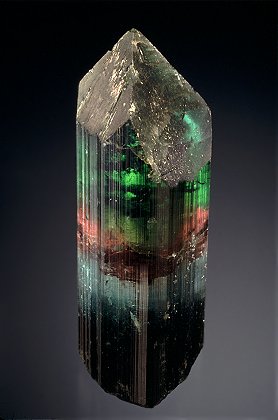 |
| Elbaite from Alto Ligonha, Mozambique, 7.6 cm. tall. From the collection of Bill Larson. (Photo: Jeff Scovil) |
In 1973, Pala went to Mexico, with Swoboda supervising the mining of boleite and cumengeite at the Amelia Mine at Santa Rosalía (El Boleó) in Baja California Sur. In 1979, Swoboda sold his interest in PPI to Larson. The new company, Pala International, then sold the Pala district mines back to Swoboda before buying the Himalaya Mine, in Mesa Grande, which PPI had leased earlier and worked with members of the Amelia crew.
The Himalaya Mine had been active during the Empress Dowager’s gem craze and in fact was years later leased and owned by Chinese gem buyer “Tom” Quin. In the early 1950s its new owner, Ralph Potter, found crystals in a new tunnel on the mine’s west side. Traveling across the country, he sold the mine’s output and built its reputation. It was a consortium formed by Potter that sold Larson the Himalaya. From 1981 when Pala constructed its new 750-foot tunnel, to mine’s closure in 1997, the company put in 13,000 feet of tunnel—mapped by Kennecott Mines. The mine produced two tons of tourmaline during Pala International’s operation.
Other local Pala International mining ventures included two Hiriart Mountain (Pala district) mines: the Sempe, which produced morganite specimens and ceased operations in 1978, and the San Pedro, which produced a fine aquamarine specimen now housed at the San Diego Natural History Museum.
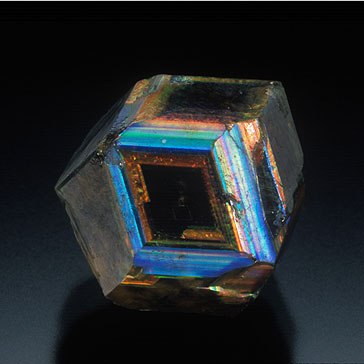 |
| Iridescent andradite crystal, 1.1 cm. wide, Sonora, Mexico. From the collection of Bill Larson. (Photo: Jeff Scovil) |
In the early 1980s, Pala International entered into a sapphire dredging project in Sri Lanka—the country’s first legal foreign joint venture. (The Tamil separatist insurgency, however, nipped this promising venture in the bud…) Since that time, Pala International has consulted on mineral specimen and gem mining projects in Kenya, China, Russia, and Burma. One of the more recent mining ventures (2005–06) involved iridescent andradite (garnet) in Alamos, Sonora, Mexico.
A Pillar of Industry
Bill Larson was integral in the formation of the American Gemstone Trade Association in 1981 and served on its board for six years. Three years later, Larson helped found the International Colored Gemstone Association and currently is ICA Ambassador to the United States. He is the only gemstone dealer to have been honored with a seat on the board of governors of the San Diego Museum of Natural History.
Just as most of us consult our watches for the time, Larson must have to consult his for the time zone. Over the years he’s made 40+ trips to Africa, 35 to Sri Lanka, roughly 100 to Thailand, 33 to Burma, many to Russia and Vietnam, and perhaps 100 to Europe. Pala International has been a fixture at numerous trade shows and conferences, including the granddaddy of them all, Tucson, since 1969.
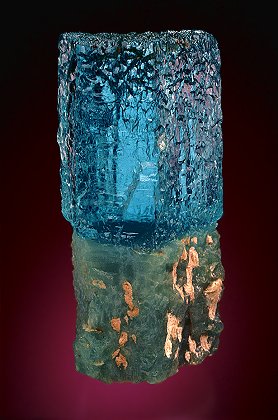 |
| Beryl var. aquamarine from Teófilo Otoni, Minas Gerais, Brazil, 12.6 cm. tall. From the collection of Bill Larson. (Photo: Jeff Scovil) |
Bill Larson has enjoyed professional relationships and friendships with some of the giants in the mineralogical world, including John Sinkankas, who Larson met at age 14 on a field trip to the benitoite mine, and who amongst other things helped Larson acquire two thousand volumes for a library that includes rare lapidaries and a focus on Asia and Baja California; Eduard Gübelin, for whom Larson performed the first comprehensive, professional-dealer appraisal of this gemological giant’s personal collection, now housed at GIA, and to which Larson had contributed; and Peter Bancroft, a gemological and mineralogical scholar, author, and lecturer who actually introduced Larson to Dr. Gübelin when Bancroft was resident mineral specialist at Pala in 1974. (Dr. Bancroft’s classic Gem & Crystal Treasures currently is being revised in conjunction with BlueCap Productions for a 2010 reissue.)
Among collectors, Michael Scott stands out—“sending me to find impossible things like the 9.2-carat faceted Burmese ruby [that] Dr. Gübelin certed as one of the finest ever seen,” Larson says, “and ‘Big Momma,’ the 10,041-carat giant ruby crystal from Burma.” Two hundred pieces of Scott’s collection are displayed as part of a traveling exhibition, Light & Stone, currently at the Royal Ontario Museum through November 15. The exhibition was accompanied by a monograph published by the Bowers Museum. Scott chose Harold and Erica Van Pelt to photograph the collection. Larson first met the Van Pelts in 1968, which began a lifelong friendship that remains today. “They are the great mineral and gem photographers, pioneering many techniques that long predate digital,” Larson says. “They helped Pala document its mining ventures and created photographs of superb specimens that graced the covers of The Mineralogical Record as well as some of the most important mineral books for the next four decades. Our friendship also has forty years of history.”
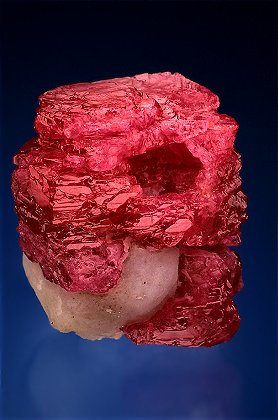 |
| Ruby from Mogok, Burma, 4.5 cm. tall. From the collection of Bill Larson. (Photo: Jeff Scovil) |
A Committed Crew
While building a personal mineral collection that is considered one of the finest ever assembled, Bill Larson also has built a wholesale business team that is virtually synonymous with the term “fine colored gemstones.” To support him, he’s had a dedicated group—retaining three members of Pala’s senior staff, in particular, for decades: John McLean (1971), Pala’s director of mining, who was instrumental in the locating and unearthing of the famous blue-cap find; Josh Hall (1976), who as VP of the enterprise oversees the day-to-day operation of everything from mailings to organizing trade shows, and also is a board member of The GemGuide (a quarterly wholesale pricing reference); and Gabrièl Mattice (1988), staff gemologist, who enjoys advising connoisseurs and tracking down those rarer, more difficult acquisitions.
The company website, Palagems.com, will celebrate its own ten-year anniversary this coming February. Developed in 1999 by author and then-staffer Richard W. Hughes, the site is not only home to Pala’s online catalog, but is a storehouse of valuable reference information, historical reprints, and developing news.
Larson and crew have counseled collectors and have stocked the exhibition cases of countless museums, both by gifting and by acquisition advisement. Likewise, Larson’s writings have appeared in all the literature, his presentations have enhanced many a trade show and symposium, and his “bites” have been featured in both industry and popular news media. (An example of the man in action is featured in the recent re-release on DVD of The Golden Age of Minerals, mentioned below in this month’s Mineral News.)
Mineral specimen aficionados in particular are familiar with The Collector, Pala’s retail affiliate, which opened in Fallbrook in 1971. In addition to fine jewelry, The Collector deals in world-class, and more affordable, mineral offerings. With the new addition of Will Larson, the coming months will see a move of the mineral sales to their own operation: Palaminerals.com.
For more on Pala’s forty-year history, see the following.
- The Queen Reigns Again – Bill Larson’s detailed description of the “find of the century” at the Tourmaline Queen Mine, from Lapidary Journal, October 1972
- Tsavorite – From Peter Bancroft’s 1984 classic Gem & Crystal Treasures, which includes photos by Bill Larson during his work with Peter Morgan
- Meet the Larsons: Globe-Trotting Collectors – A mid-point profile of Bill and Jeanne Larson, including pre-Pala biographical details, from Ranch & Coast magazine, April 1990
- California Gem Mining: Chronicle of a Comeback – David Federman’s look at the “restored splendor” of San Diego’s mining operations, from Modern Jeweler, September 1991
- The San Diego–China Connection – Bill Larson’s talk delivered in Beijing, October 2006
- Meet Pala’s Gem and Mineral Experts – Brief bios of Pala’s current staff
- Mining at Pala – An overview of some of Pala’s mining ventures, on Palagems.com [back to top]
Mineral and Mineralogy News
Viking Compass and the Usambara Effect
Cornell’s Elise Skalwold looks at phenomenal minerals
In our last issue, when we pointed to Cornell University’s mineral and gemstone collection, we began a dialogue with gemological curator Elise Skalwold. When we asked her to keep us posted on developments with the collection, she modestly pointed us to her website, nordskip.com, which she described as “a growing collection of eclectic themes aimed at exploring gemological properties in unusual ways…bending diamonds for instance, that's next….”
We take a look here at two subjects from Skalwold’s website that are a bit off the beaten track…
Viking Compass
According to “The Fabled Viking Sunstone (also known as Viking Compass),” a navigational tool in the form of a stone is mentioned in ancient Viking sagas. These tales, which were written down in the late Middle Ages, recall (amongst other things) the adventures of explorers during what is now known as söguöld, or “period of legends”—roughly the 10th century. Voyages to the New World were recounted in the sagas as well, and were mistakenly thought to have been mere fables. Navigation by a stone likewise might have been dismissed but for the work of insightful scholars.
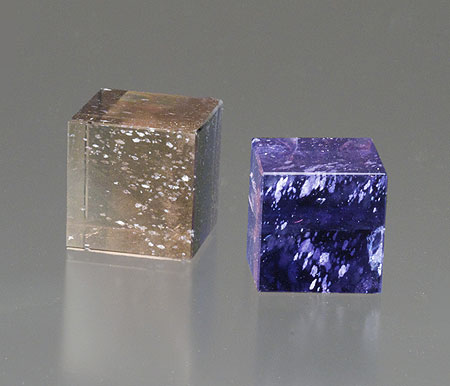 |
| Depending on its orientation, iolite/cordierite can be perceived as near-colorless or bluish. The sample on the right, above, in fact tends toward brown when its orientation is altered. Gemmy material, like the faceted iolite below, as well as other minerals with useful optical qualities, could have aided Viking navigators. (Photo: Mia Dixon, above; Elise Skalwold, below) |
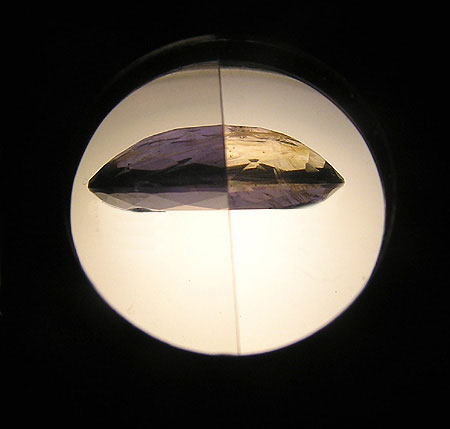 |
The terms associated with these navigational aids—“compass” or “sunstone” [see note]—actually apply to a number of materials, both real and “theoretical,” that could have been used by Nordic navigators. The polarizing optical properties of these minerals are thought to have allowed pilots to see the “hidden sun” obscured by subarctic mists. Such a theory was, according to Skalwold, first proposed in 1969 by Thorklid Ramskou, the Danish archeologist who coined the term Vikingernes Kompas, as it relates to iolite (aka cordierite). At the time of Ramskou’s hypothesis, a modern version of an instrument utilizing polarizing optics was in fact in use—by Scandinavian Airlines pilots on trans-arctic flights.
Other materials that could have been employed include calcite rhombs, which feature an optical doubling property. This theory is supported by the work of the late Viking navigator expert, Leif K. Karlsen, author of Secrets of the Viking Navigators.
Read the full, fascinating story of medieval Nordic ingenuity here.
––––––––––
*In this context, “sunstone”—solstenen in Norwegian—is the term used by the ancient Nordic mariners; it should not to be confused with the term applied to a variety of feldspar. [back to text]
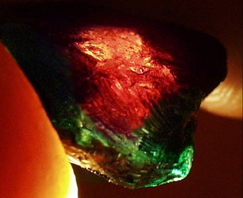 |
| Usambara-effect chrome tourmaline in transmitted light. Notice the abrupt change to red marking the critical thickness change-over point. (Photo: Jan Kihle at Institute for Energy Technology courtesy of Asbjørn Halvorsen) |
Usambara Effect in Chromiferous Green Tourmaline
Norwegian geologist Asbjørn Halvorsen discovered an unusual phenomenon in the early 1990s. Having collected samples of chromiferous green tourmaline in Nchongo area of northeast Tanzania’s Umba River valley, Halvorsen fully expected to see color-change. After all, the valley is famous for this phenomenon in garnet, tourmaline, and sapphire.
In addition to typical color change, what Halvorsen saw in his new samples was altogether different. In transmitted light, if the sample reaches a particular thickness (always the same, even using stacked crystals), the transmitted light’s perceived color made a dramatic shift to red.
In a 1997 paper published in the British Journal of Gemmology, Halvorsen, along with Brenda Jensen of the Mineralogical Museum of Oslo, called this the “Usambara effect,” after the mountain range that is the source of the Umba River. This led to ten years of study and two more papers in the Journal of Gemmology, the last a cover feature in 2006.
Elise Skalwold told us, “My fascination with the Usambara effect was fueled by Asbjørn’s generous loan of the original specimens to me for study. He also was a great teacher for me in this subject and we spent much time writing back and forth.”
We’ve only hinted at the intriguing science behind this phenomenon; the full story is available here. [back to top]
SSEF Offers Portable Spectrometer
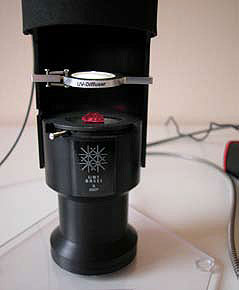 |
UV-Vis Tool Developed with University of Basel
Need an idea of what to get that picky patriarch for Father’s Day? May we suggest the SSEF Swiss Gemmological Institute’s portable spectrometer? At 24,000–30,000 Swiss francs (plus VAT and shipping), you might want to pool with your siblings, but it’s a gift Dad will never forget.
According to a presentation by SSEF’s Dr. Krzemnicki a year ago, the tool was developed with M. Steinacher, of the University of Basel’s Physics Department. Using a simultaneously, rather than sequentially, diffracted light source, it measures absorption, transmission, and even luminescence, which previously wasn’t available using older spectrometers.
The components are very light and come with the AvaSoft application. The Pro version includes a Windows PC with the software installed, a spectral database of gemstones, and metallic travel-trolley case. See this flyer for a full list of features. [back to top]
BlueCap Productions Update
Something old, something(s) new
Since we’re celebrating Pala International’s 40th birthday this month, let’s take time to celebrate the re-issue, on DVD, of a five-year-old (as well as a couple more in the oven).
The Golden Age of Minerals, an event held at the 2004 Westward Look Mineral Show, brought together six iconic figures of the mineral collecting world: Charlie Key, Peter Bancroft, Ed Swoboda, David Wilber, Bill Larson and Steve Smale. This once-in-a-lifetime evening of storytelling and Q&A was captured by BlueCap Productions. It’s available now on DVD for the first time here.
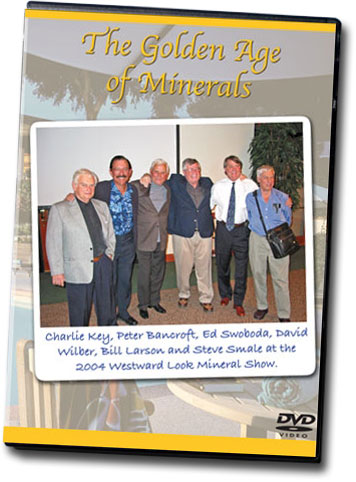 |
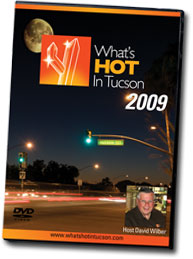 |
BlueCap, of course, doesn’t dwell on the past. In an effort to encourage the younger set, the New Crystal Hunters series will offer an installment to be shot in Arkansas in July. And, we’re told, the young folk also will be traveling this summer to the amazonite mines of Colorado.
Of course, if you missed this year’s Tucson show but still want to catch up, BlueCap offers its annual rockumentary. What’s Hot in Tucson 2009, scheduled for release this month, will feature:
- 2 DVDs with over 4 hours of footage
- Scovil’s Top Ten Photos from Tucson 2009 – See also a special 11-minute “shoot set-up,” Mineral Artists: Jeff Scovil (available separately)
- New: Host David Wilber builds a mineral collection with specimens that are $99 or less
- New: Every mineral specimen featured on the DVDs now has an on-screen label with name and locale
And finally, we’ve been told by BlueCap’s Bryan Swoboda, “We’re starting a new series called Inside the Mineral Museum, which begins filming this summer with a very special surprise host.”
And remember friends of Pala International get a 10% discount on any BlueCap order. Just enter the code palaintl when you’re asked for it while ordering. [back to top]
— End June Newsletter • Published 6/8/09 —
April 2009 Newsletter
Shows and Exhibitions
- West Coast Gem & Mineral Show – May 15–17, 2009
- Houston Fine Mineral Show – May 1–3, 2009
- A Take on Tucson
- Cornell Displays Mineral, Gem Collections
Pala International News
Mineral and Mineralogy News
- The New Hot Spot
- Chips & Chunks
- Michael Collier’s “Stones from the Sky”
- Music: The Minerology [sic] Series Part 1, The Bismuth EP
- New Crystal Hunters: Next Stop Arkansas
Shows and Sales
West Coast Gem & Mineral Show – May 15–17, 2009
 |
| Silver serpents. Mineral shows offer more than just crystalline specimens. This silver on matrix, from the Uchucchacua Mine, in the Lima Department of Peru, measures 3.8 x 4.1 x 2.7 cm. This is available. (Photo: John McLean) |
Several members of the Pala staff will attend this show. See you there!
Event: West Coast Gem & Mineral Show
When: May 15–17, 2009
Where: Holiday Inn – Bristol Plaza, Costa Mesa, CA
[back to top]
Houston Fine Mineral Show – May 1–3, 2009
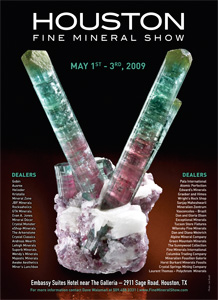 |
The Dallas Fine Mineral Show moves to Houston this year.
Please note: We regret that Pala International will not exhibit at this year’s show. At the time of the show, Bill Larson will still be in the Far East traveling to obtain new gems and crystals.
Event: Houston Fine Mineral Show
When: May 1–3, 2009
Where: Embassy Suites Hotel, Houston, TX
[back to top]
A Take on Tucson
This year’s Tucson Gem and Mineral Show was hopping despite the economic woes. All the usual suspects were out for a fix: good stories, good laughs, and great rocks.
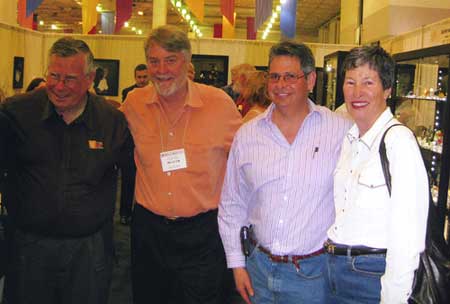 |
| Tucson time. Dave Wilber, Bill Larson, new mineral enthusiast Scott Rudolph, and Dallas entrepreneur–philanthropist Lyda Hill. (Photo: Jim Gibbs) |
The über-booth was the crossroads once again, with constant banter and laughter echoing from the area. There were even some some misguided champagne corks flying around that added to the distinguished crowd.
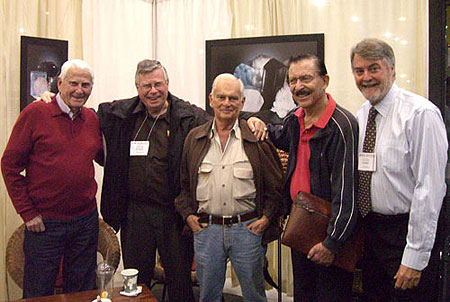 |
| Legends: Ed Swoboda, Dave Wilber, Charles Key, Peter Bancroft, Bill Larson. (Photo: Will Larson) |
There were plenty of recognizable faces from miners, collectors, authors, researchers, and some newcomers.
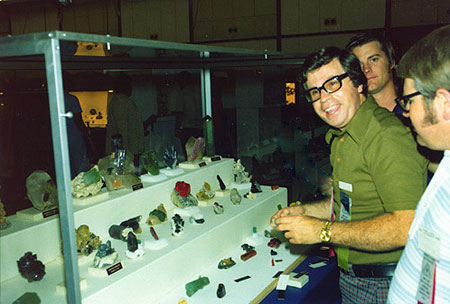 |
| Old School Photo: Dave Wilber (left) with Bill Larson peeking though in the background, circa 1976. (Photo: Jerry Wentling) |
[back to top]
Cornell Displays Mineral, Gem Collections
Heasley Mineralogy Museum in Snee Hall
In February, New York’s Cornell University unveiled scores of mineral specimens and faceted gemstones from the collections of alumni, faculty, and friends. The collections are housed in the Timothy N. Heasley Mineralogy Museum, in Snee Hall, home to the Department of Geological Sciences.
 |
| Bill Bassett, professor emeritus of geological sciences, in the Timothy N. Heasley Mineralogy Museum, housed in Cornell University’s Snee Hall. (Cornell University Photography photo by Jason Koski) |
The individual items are arranged according to the Dana classification system and include a fine 1865 California gold nugget featuring gold crystals. Read more at Cornell’s ChronicleOnline. [back to top]
Pala International News
Pala’s Featured Mineral Specimens: Bigger Is Better
In the Heavyweight Division…
This month we though we’d whip out some big minerals for those who like some poundage for their buck. In this heavyweight mineral bout we feature a large, classic pink tourmaline from Afghanistan and a monster feldspar oddity from Madagascar. Pala’s Bill Larson acquired this historic piece, which dates back to the mid-20th century, at last year’s Munich show.
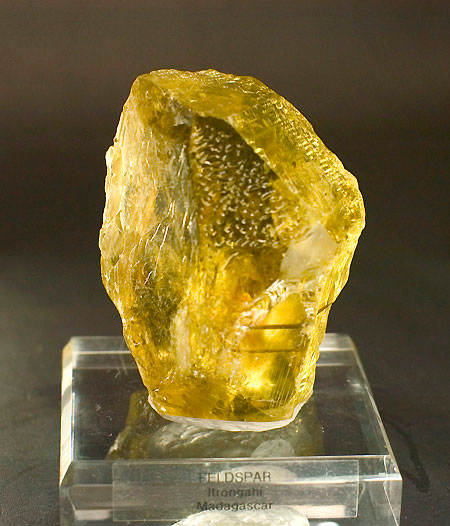 |
| Feldspar. Dimensions 4.5 x 3.5 x 2.25 inches. Price available upon request. (Photo: Jason Stephenson) |
In this corner, weighing in at 1.77 lbs., an outstanding orthoclase feldspar single crystal from Itrongahi (aka Itrongay), Madagascar.
This is arguably the largest gem orthoclase crystal on the planet. This behemoth not only exhibits some complete crystal faces, it also contains a large amount of gem-worthy portions. The intense, slightly greenish-yellow hue is very deceiving at first, as your first synapse calls out, “Heliodor.” But as the crystallography is illuminated, it’s clearly from the feldspar family.
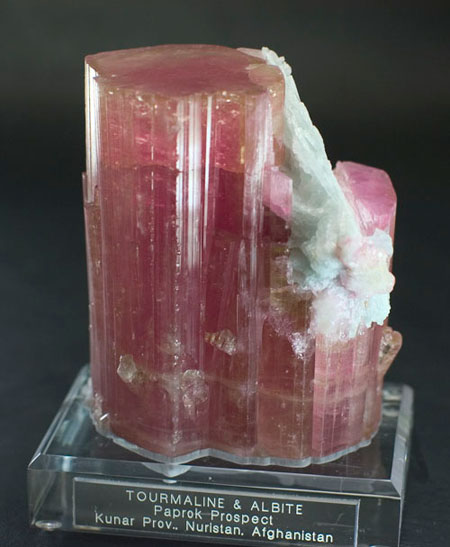 |
| Pink tourmaline. Dimensions 4.5 x 3.5 x 2.5 inches. Price available upon request. (Photo: Jason Stephenson) |
In this corner, weighing in at 2.82 lbs., our second feature is a massive pink tourmaline crystal with an albite plate splitting the main crystal from a smaller secondary termination.
Here we have a classic pink tourmaline from the Paprok prospect of northeastern Afghanistan; a striated shaft with small tourmaline crystals popping out all around. The specimen is capped by a thin green layer and a flat termination. It features a beautiful assortment of light and dark pink hues mixed with the white albite and a few greenish zones.
Larson Opals Grace AMNH Case
Recent Gifts Create Exquisite Display
On February 26, a single display case containing opals debuted at the entrance of the American Museum of Natural History’s Harry Frank Guggenheim Hall of Minerals. The twenty-five opals included—featuring several gifted by Bill and Jeanne Larson—are from diverse localities of Australia, Brazil, Honduras, Ethiopia, and the United States. (According to the AMNH, all but 15% of the world’s gem opals are produced in Queensland and New South Wales.)
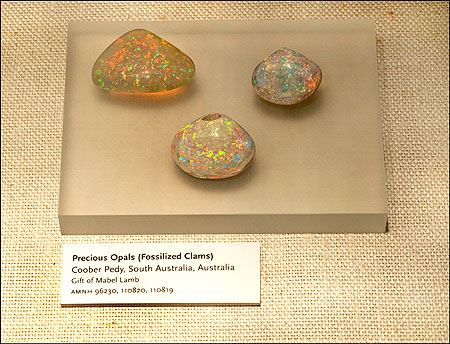 |
| Clam bake. Opals in the guise of fossilized clams are formed by a hydrothermal process within “molds” in rock, left by bivalves that have decomposed. (Photo courtesy American Museum of Natural History) |
Fossilized opals also are on display in the exhibit. For an explanation of such fossil formation, see:
- March 10 article in National Jeweler
For more photos, see:
- A photo gallery of opals at American Museum of Natural History
- National Jeweler’s 10x blog
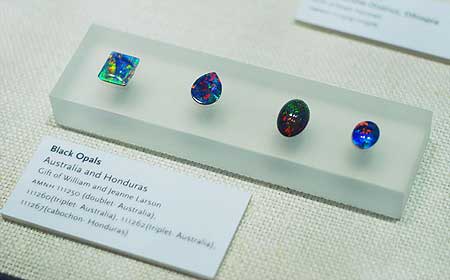 |
| Black opals gifted by Bill and Jeanne Larson: (l–r) Doublet and two triplets from Australia, and cabochon from Honduras. (Photo: Thomas Rosinski/National Jeweler) |
[back to top]
Mineral and Mineralogy News
The New Hot Spot
In-situ study of magma presents unprecedented “opening”
A unique scientific opportunity occurred as Puna Geothermal Venture workers were drilling into the volcanic crust on the eastern edge of the big Island of Hawaii. Boring down through the strata of solidified lava flows from the nearby Kilauea volcano, geologists punctured a shallow magma chamber. As the drill moved from hard rock to magma, the liquid shot up the bore-hole 5–10 meters before solidifying. The project was designed to find steam underground that would drive turbines on the surface to generate electricity.
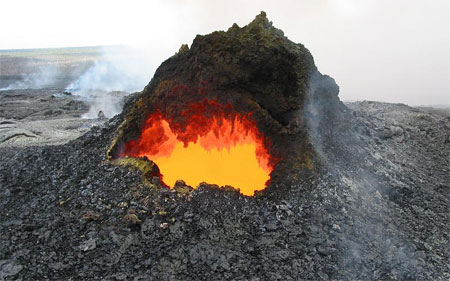 |
| Molten maw. Unlike the surface eruption pictured above at a Hawaiian volcano, scientists at Kilauea in 2005 had the unique opportunity to study magma “in its natural habitat.” (Photo courtesy U.S. Geological Survey) |
This chamber of liquid rock was encountered at a relatively low depth of only 2.5 km. This geothermal-anomaly surprised geologists: it’s unprecedented to find such a structure that maintains temperatures around 1050° C. Similar projects in Europe and Australia had drilled twice as far and encountered temperatures around only 260° C.
The chemistry of the magma is also unique, with 67% silica content, defining it as a dacite. This means there is a mixture of basaltic (50% silica) and granitic (75% silica) type magmas. The Hawaiian islands are comprised mainly of basaltic rocks or oceanic-type crust and granitic rocks, which make up the majority of continental crusts. This means we are seeing the first continental/ granitic-type magmas being introduced into the conduit under the Hawaiian island-chain hot spot.
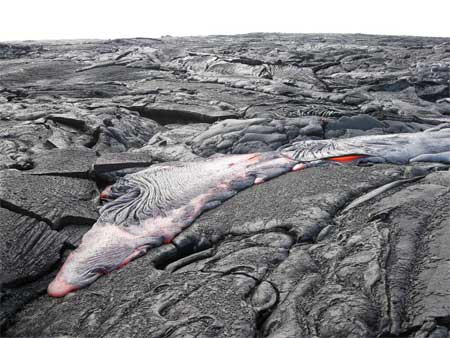 |
| Pretty / hot. While Prof. Bruce Marsh was announcing results of in-situ magma research to the American Geophysical Union in December, Kilauea’s lava flows—above the surface—were inching toward the eastern boundary of Hawaii Volcanoes National Park. (Photo courtesy U.S. Geological Survey) |
Although the opportunity for study of the magma chamber first took place in 2005, it was only made public in December 2008, by Professor Bruce Marsh of Johns Hopkins University. Read more at BBC. [back to top]
Chips & Chunks
Michael Collier’s “Stones from the Sky”
Michael Collier, with a 34-year career in aerial photography, is featured in an exhibition, “Stones from the Sky,” at the Denver Museum of Nature & Science through August 2.
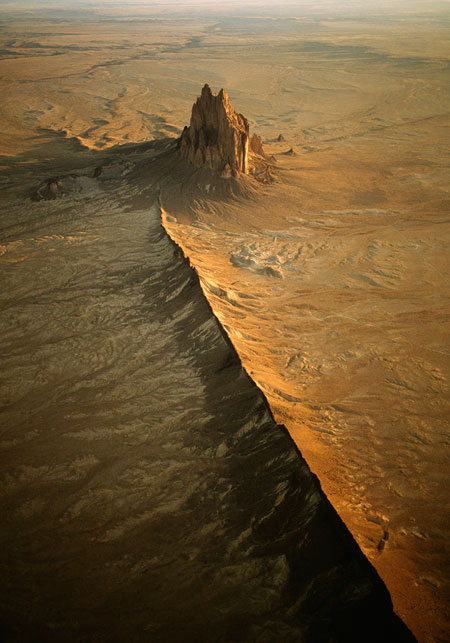 |
| Shiprock, New Mexico. Called Tsé Bit’a’í or “Winged Rock” by Navajos who live in its shadow, Shiprock is the core of an extinct volcano. Since its eruption 30 million years ago, erosion has lowered the surrounding landscape by 3,000 feet, thus exposing the 1,800-foot-tall heart of the volcano. Its radiating wings or dikes of injected igneous material extend toward the bottom of the picture. (Photo: Michael Collier, courtesy Denver Museum of Nature and Science) |
This exhibition focuses on American geologic landscapes. If you can’t visit Denver, you can visit an NPR audio slideshow of his work. Collier has two geology degrees as well as an MD, and is the author of several books. [back to top]
Music: Minerology Series Part 1, The Bismuth EP
What they lack in spelling skills, the folks at the British Reverberations music collective make up for in reminding us of the beauty of bismuth. For those of you with your periodic table still committed to memory, the element bismuth is Bi at No. 83. But if its physical appearance doesn’t come to mind easily, that’s because bismuth crystals aren’t normally found in nature. Hopper crystals, however, can be lovely, as evidenced by the cover photo of the “Bismuth EP,” (itself lifted from Wikipedia).
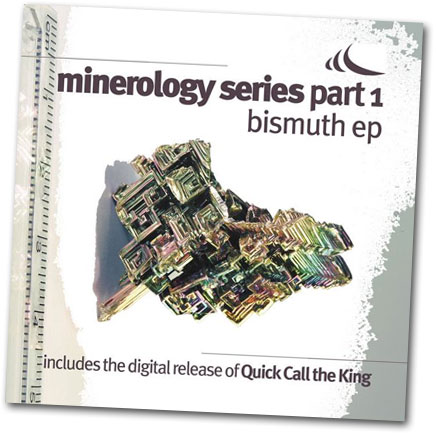 |
For more on bismuth (the element) see this gorgeous crystal photo by “Dschwen” (designer David Schwen), and this funky Wooden Periodic Table Table by Theodore W. Gray. For the music—classified as “house” on Beatport—see the Reverberations Facebook page. [back to top]
New Crystal Hunters: Next Stop Arkansas
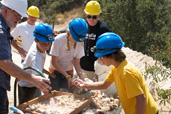 |
Last issue of Pala’s Mineral News, we noted the debut at Tucson of BlueCap Productions’ New Crystal Hunters: Pala, a DVD following young mineral fans in Southern California’s famous mining district. After the show, we received the following from BlueCap regarding the kids’ next adventure:
New Crystal Hunters is now moving full steam ahead with their second episode, New Crystal Hunters: Arkansas, which will film later this summer. “We’ve made a few format changes that will make this program have an even broader appeal,” says Swoboda. “Despite the downturn in the economy, I predict that we’re going to see a huge emergence of kid-related mineral efforts in the next year or two. This may very well be the beginning of the next Golden Age of Minerals.”
The DVD donor program was a big hit at Tucson, too:
With prices in the Donor Program going for as low as $4 per DVD and the ability to put any name or logo on the front of the DVD, the response was tremendous. Bryan Swoboda, President of BlueCap Productions, said, “It was amazing. Before the TGMS show even started donors had provided over 500 copies of this DVD for the kids. Everywhere I turned people wanted to know more about this series and what they could do to help. By the second day of the show I had seven other potential episodes planned. We even had a bunch of New Crystal Hunters stickers that we were asking people to wear if they supported the program. So many people ended up wearing stickers that one of the police officers working the exhibit hall finally came up to us and asked us why everyone he saw was wearing a sticker! It is absolutely thrilling to see everyone so enthusiastic about helping to get more kids into our hobby.” [back to top]
— End April Newsletter • Published 4/3/09 —
February 2009 Newsletter
Shows and Sales
- Bill Larson to Speak at Tucson
- Tucson Time – February 4–15, 2009
- New Crystal Hunters DVD “Episode 1 – Pala” To Be Released in Tucson
Pala International News
Mineral and Mineralogy News
Shows and Sales
Bill Larson to Speak at Tucson
Pala International President Bill Larson will present a free seminar at next week’s AGTA GemFair in Tucson, entitled “Collectors of Gems and Minerals: How and Why.”
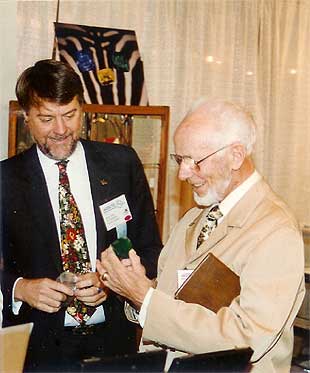 |
| But could you lose the tie…? Bill Larson (left) with Dr. Gubelin, examining specimens at an exhibition. (Photo: Marie-Helen Gubelin Boehm) |
The presentation is targeted at the basic-to-intermediate level:
Collector Bill Larson follows a fine tradition of a few noteworthy gem and mineral collectors such as Dr. Edward Gubelin, Dr. Peter Bancroft, and John Sinkankas whose collections have informed the industry and who were themselves inspiration for, and mentors to, Larson. In this session Larson discusses the collector’s impulse, how to build your own gem and mineral collection, and reveals some of his holdings while appreciating the import of other gem and mineral collectors.
This presentation will make a great companion piece to Jason Stephenson’s “Collecting and Investing in World Class Gemstones” featured previously in Pala’s Gem News.
Seminar: Collectors of Gems and Minerals: How and Why
When: Saturday, February 7, 2009
Time: 1:00 – 2:00 p.m.
Where: AGTA GemFair, Maricopa Room, Tucson Convention Center
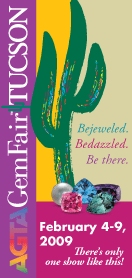 |
Other Tucson Highlights and Details
Highlights of the world’s greatest gem and mineral show include:
- Display of American Gem Trade Association Spectrum and Cutting Edge Awards winning collections
- Smithsonian Institution Special Exhibit: Highlights from the home of the Hope Diamond travel to the AGTA GemFair, along with Jeffrey Post, Ph.D., curator of the National Gem Collection
- The theme of this year’s Tucson Gem and Mineral Show is “Mineral Oddities”
See Pala International’s page on the Westward Look Show site.
Pala International will be represented in Tucson as follows.
Event: AGTA GemFair
When: February 4–9, 2009
Where: Tucson Convention Center
Booth: 1016–1018
Event: Westward Look Mineral Show
When: February 6–9, 2009
Where: Westward Look Resort
Suite: 236
Website: Official show website
Event: 55th Annual Tucson Gem and Mineral Show
When: February 12–15, 2009
Where: Tucson Convention Center
Booth: Aisle 5 East
We look forward to seeing our many friends there. Visit the Pala International Show Schedule for future events. [back to top]
Tucson Traffic Tips
Highway construction in Tucson will continue to impact travel. Use these resources to save yourself a headache.
[back to top]
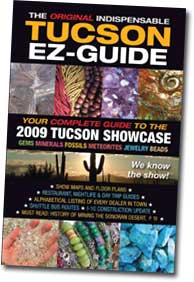 |
Tucson EZ-Guide Available
For Download
The 2009 Tucson EZ-Guide is now available online. This is the same guide that will be available at all the show venues, shuttle routes, and Tucson International Airport. It features a list of exhibitors and their locations. (You’ll find Pala International on page 148.)
The guide also includes maps, floor plans, traffic tips, a restaurant guide, and other show information.
You can download the 16.6MB PDF here. [back to top]
New Crystal Hunters “Episode 1 – Pala”
To Be Released in Tucson
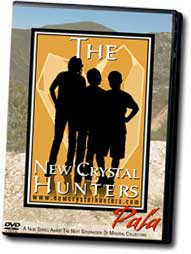 |
Donor program makes DVD available to kids free of charge
In the last issue of our Mineral News we mentioned a DVD that follows three young people exploring mines in the Pala district of Southern California. The DVD, the first in a series from BlueCap Productions called The New Crystal Hunters, will be released on February 12, 2009 at the 55th Annual Tucson Gem and Mineral Show.
BlueCap Productions’ Bryan Swoboda told us that he’s begun a donation program with the intent of getting the DVD in the hands of as many kids as possible—free of charge.
On display at the Tucson Gem and Mineral show, look for one of the major specimens collected by the youngsters: a smoky quartz crystals with phantom inclusion (pictured with Max, below). The crystal will be donated to the Fallbrook Gem and Mineral Society. BlueCap Productions is sharing display space this year with Pala International at the Main Show, Aisle 5 East.
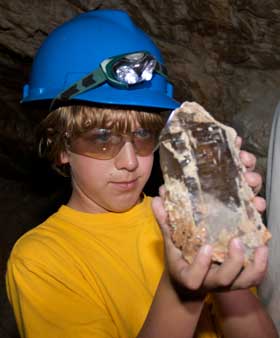 |
[back to top]
Pala International News
Pala’s Featured Mineral Specimens: Romanian Calcite
Is this odd to you?
How odd does a mineral have to be to qualify as an oddity? This year’s Tucson mineral show, with its theme “Mineral Oddities,” will be the pool to dive into and ponder the shtick surrounding the word as it relates to the mineral world, and engage the sticklers who indulge in the unusual.
Minerals are the end-members—born out of a chaotic convergence of chemistry, heat, time, and pressure—representing the infinite possibilities of crystal formation. Every mineral specimen is unique and some leave a lasting, sometimes odd, impression. A recognizable form or personified rock can be a visual stimulant that skips the usual beat and requires a second look. An animal form, a miniature landscape, geometric shapes, and, of course, balls of all sizes and textures.
We though we’d show you a few calcite balls of our own—from Romania: coconut twin spheres and some prickly conjoined ones.
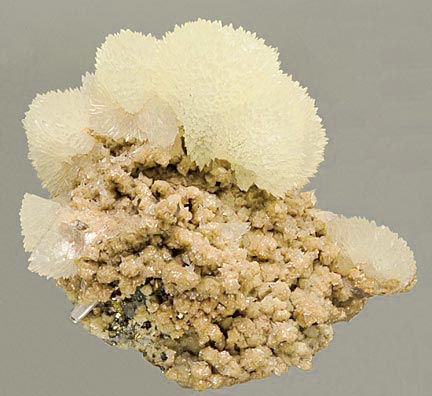 |
| Pack of porcupines? Dimensions 9 x 5.5 x 7 cm. (Photo: John McLean) |
These oddball calcite orbs come to us from Romania. The first one is from the Boldut mine in Cavnic, Romania. It’s an interesting assemblage of calcite clusters huddling together like a family of porcupines.
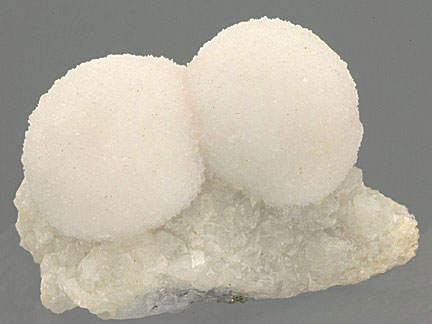 |
| A double-shelled snail? Dimensions 4.6 x 2.8 x 3.1 cm. (Photo: John McLean) |
The second specimen is from an undetermined locality in Romania and conjures up all sorts of strange associations.
Interested? Email us, or give us a call. Or see them for yourself—and the other oddities we’ve assembled—in Tucson. [back to top]
Mineral and Mineralogy News
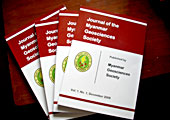 |
Myanmar Geosciences Society
Issues New Journal
Mogok Stone Tract featured in debut
The Myanmar Geosciences Society (MGS) published the first edition of its English-language Journal of the Myanmar Geosciences Society in December, according to a January story in The Myanmar Times. Contents of the issue include:
- Seismicity and major active faults of Myanmar (Win Swe and Win Naing)
- Triassic organic reefs in Lungyaw-Sakangyi area, Ywa-ngan Township, Shan State (Zaw Win)
- Biostratigraphic correlation of the well sections in the Central Myanmar Basin (Than Htut and Swe Myint)
- Tertiary uplifting and exhumation of Mogok metamorphic terrain (Win Naing)
- Modes of occurrence and origin of precious gemstone deposits of the Mogok Stone Tract (Maung Thein)
The Society was established in 2003. One task being undertaken by the MGS is a revision of the geological map of the entire country, last performed comprehensively in 1977. [back to top]
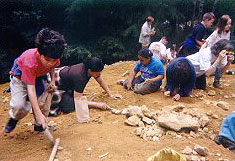 |
Crystal Kid Trips Offered by
Geology Adventures
Museum collector takes kids (and adults) to world-class localities
No, “Crystal Kid” is not a methamphetamine rehab program. It’s one of dozens of field trips offered by Bob Jackson’s Geology Adventures, based near Seattle–Tacoma, Washington.
Following our mention in December of the New Crystal Hunters DVD, Jackson wrote to let us know about the mineralogical explorations he’s been leading for twenty-five years, now involving more than a thousand adventurers a year—both kids and adults. Jackson’s “adventures” run the gamut from day trips to camping trips to international excursions in Africa and Australia.
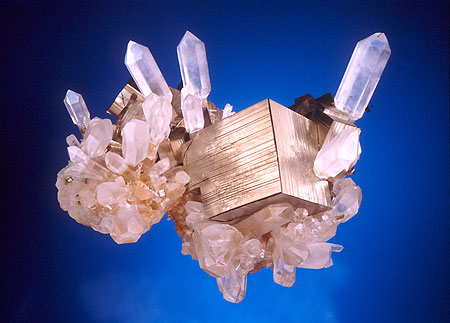 |
| Quartz scepters with pyrite, collected in 1978, now in the Bruce Oreck collection. This specimen, from the Spruce Ridge locality, King County, Washington, was featured in Bob Jackson’s display at Tucson 2008. Photo: Jeff Scovil, from American Mineral Treasures. |
Jackson, whose website home page says his mineralogical experience almost puts him into the category of a “fossil,” worked as a collector for museums and thus has entrée to world-class localities. Examples of his collecting prowess are included in the book American Mineral Treasures. We’re told that a few copies will be available for sale at the Mineralogical Record booth in Tucson next week. [back to top]
— End February Newsletter • Published 1/30/09 —